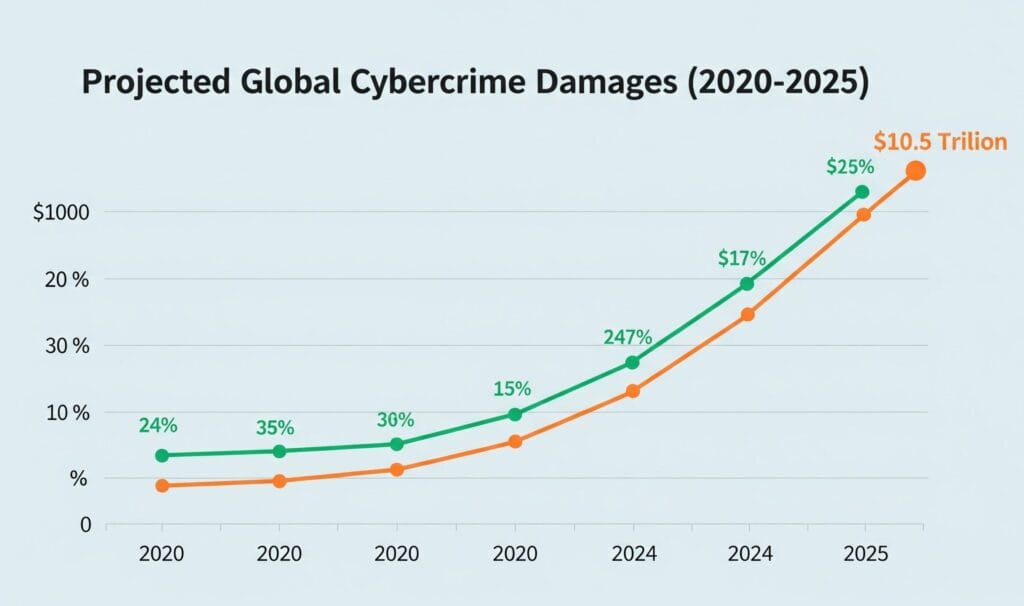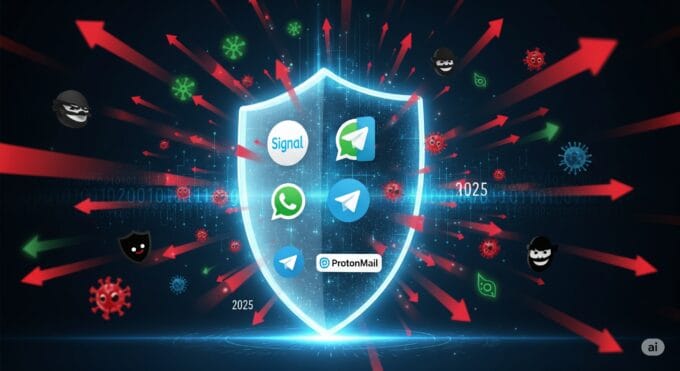In today’s fast-paced digital world, our lives are increasingly online. From banking and shopping to communicating with loved ones and managing businesses, the internet is at the core of almost everything we do. While this connectivity brings incredible convenience and opportunities, it also opens the door to a growing, unseen danger: cybercrime. This invisible threat lurks in the shadows of our networks, targeting individuals, small businesses, and large corporations alike. For technical experts and CISOs, understanding the depth and breadth of cybercrime is not just important—it’s absolutely critical for protecting digital assets and ensuring operational continuity. Let’s Understanding Cybercrime.
Critical Insights
- Cybercrime is a Pervasive and Evolving Threat: It’s a significant financial and operational risk, with global costs projected to reach trillions annually, constantly adapting to new technologies.
- Common Attack Vectors Target Vulnerabilities: Ransomware, phishing, data breaches, and business email compromise (BEC) are prevalent, exploiting both technical weaknesses and human error.
- Robust Security Requires Multi-Layered Defenses: Effective protection involves strong frameworks like Zero Trust, continuous vulnerability management, encryption, and comprehensive employee training.
- Proactive Planning is Essential for Resilience: Developing detailed incident response and disaster recovery plans is crucial for minimizing damage and ensuring swift recovery after an attack.
- The Future Demands Adaptability: Emerging threats from AI, quantum computing, and IoT vulnerabilities require constant vigilance, research, and investment in cutting-edge cybersecurity solutions.
What is Cybercrime? A Definition
Cybercrime refers to any criminal activity that involves a computer, networked device, or network. It can involve using a computer to commit a crime, such as fraud or identity theft, or using a computer as the target of a crime, like hacking or spreading malware. Unlike traditional crimes, cybercrime often leaves no physical trace, making it an “invisible threat” that can cross international borders with ease.
The landscape of cybercrime has evolved dramatically since the early days of the internet. What started as individual “hackers” seeking notoriety has transformed into a sophisticated, organized industry. Today, cybercriminals range from lone wolves to well-funded state-sponsored groups and vast criminal enterprises, all seeking financial gain, intellectual property, or disruption. They exploit vulnerabilities in software, hardware, and, most commonly, human behavior.
Key Statistics and Trends
The scale of cybercrime is staggering, posing an existential threat to businesses and national security. Top IT firms and cybersecurity research groups consistently report escalating figures:
- Escalating Costs: Cybersecurity Ventures predicts that cybercrime will cost the world $10.5 trillion annually by 2025, up from $3 trillion in 2015. This makes it the greatest transfer of economic wealth in history and a larger threat to the world economy than natural disasters.

- Frequent Attacks: A report by IBM Security indicates that the average cost of a data breach globally reached $4.45 million in 2023, a 15% increase over three years. More than half of these breaches (51%) involved customer personal data.
- Ransomware Dominance: Sophos’s “State of Ransomware 2023” report found that 66% of organizations were hit by ransomware in the past year, up from 46% in 2021. The average ransom paid also increased significantly.
- Supply Chain Vulnerabilities: Verizon’s 2023 Data Breach Investigations Report (DBIR) highlighted that 23% of data breaches involve a supply chain element, emphasizing the need for organizations to secure their entire ecosystem, not just their direct operations.
“Cybercrime is not just a technical problem; it’s a business problem, demanding strategic investment and leadership attention at the highest levels.”
These statistics paint a clear picture: cybercrime is not slowing down. It’s becoming more sophisticated, more frequent, and more costly. The evolving role of AI, both in aiding attackers and defenders, is also reshaping this landscape, as discussed in detail in insights about the AI impact on the CISO role in 2025.
Common Types of Cybercrime Affecting Organizations
Understanding the different forms of cybercrime is the first step in building effective defenses. Here are some of the most prevalent types impacting organizations:
Ransomware
Ransomware is a type of malicious software that encrypts a victim’s files, making them inaccessible. The attacker then demands a ransom, usually in cryptocurrency, in exchange for the decryption key. Even if the ransom is paid, there’s no guarantee the data will be recovered.
- Impact: Can cripple an organization’s operations, leading to significant downtime, data loss, and financial penalties.
- Recent Trends: Double extortion (exfiltrating data before encrypting it and threatening to publish it) and triple extortion (adding DDoS attacks or contacting customers) are becoming common.
- Prevention: Regular backups, strong endpoint security, and employee training are crucial. For recovery, understanding how to remove ransomware is vital.
Phishing & Social Engineering
Phishing is a deceptive attempt to trick individuals into revealing sensitive information, such as usernames, passwords, or credit card details, often by disguising as a trustworthy entity in an electronic communication. Social engineering encompasses a broader range of psychological manipulation techniques.
- Impact: Leads to credential theft, malware infections, and unauthorized access to systems. Human error remains a leading cause of breaches.
- Examples: Email phishing, spear phishing (targeted), whaling (targeting executives), smishing (SMS phishing), vishing (voice phishing).
- Prevention: Employee awareness training, email filtering, and multi-factor authentication (MFA).
Data Breaches
A data breach occurs when unauthorized individuals gain access to confidential, sensitive, or protected data. This can happen through hacking, malware, insider threats, or accidental exposure.
- Impact: Financial losses, reputational damage, legal liabilities (e.g., GDPR, CCPA fines), and loss of customer trust.
- Examples: Theft of customer databases, intellectual property, employee records, or financial information.
- Prevention: Robust access controls, encryption of sensitive data (learn how to encrypt sensitive files), regular security audits, and secure coding practices. The use of encrypted apps amid cyberattack 2025 will become even more critical.
Malware (Viruses, Spyware, Trojans)
Malware (malicious software) is a broad term for any software designed to cause damage to a computer, server, client, or computer network.
- Impact: Data corruption, system slowdowns, spying, unauthorized access, and resource exploitation (e.g., cryptojacking).
- Examples: Viruses (self-replicating), worms (self-propagating across networks), Trojans (disguised as legitimate software), spyware (monitors user activity), adware (unwanted ads).
- Prevention: Antivirus software, firewalls, regular system updates, and cautious downloading.
DDoS Attacks
A Distributed Denial of Service (DDoS) attack overwhelms a system, server, or network with a flood of internet traffic, making it unavailable to legitimate users.
- Impact: Service disruption, lost revenue, reputational damage, and can sometimes be a smokescreen for other malicious activities.
- Examples: Volumetric attacks (overwhelming bandwidth), protocol attacks (exploiting protocol weaknesses), application layer attacks (targeting specific applications).
- Prevention: DDoS mitigation services, traffic filtering, and network segmentation.
Business Email Compromise (BEC)
BEC is a sophisticated scam that targets businesses performing wire transfers and has suppliers abroad. It involves tricking employees into transferring money to a fraudulent account, often by impersonating a senior executive or a trusted vendor.
- Impact: Significant financial losses, often unrecoverable, and damage to business relationships.
- Examples: CEO fraud, invoice fraud, attorney impersonation.
- Prevention: Robust verification processes for financial transactions, employee training, and email authentication protocols (e.g., SPF, DKIM, DMARC).
Why Organizations Are Prime Targets
Organizations are attractive targets for cybercriminals for several reasons:
- Valuable Data: Businesses hold vast amounts of sensitive data, including customer information, financial records, intellectual property, and trade secrets, all of which can be sold or exploited.
- Interconnected Systems: Modern businesses rely on complex, interconnected IT infrastructures, creating numerous potential entry points and a wider attack surface.
- Human Element: Employees, regardless of their technical expertise, can be the weakest link. Social engineering tactics exploit human trust and curiosity.
- Financial Resources: Organizations have deeper pockets than individuals, making them more lucrative targets for ransomware and BEC scams.
- Operational Disruption: Disrupting a business can be a powerful leverage point for attackers, forcing compliance with demands.
The Impact of Cybercrime on Businesses and Individuals
The consequences of cybercrime extend far beyond immediate financial losses:
- Financial Losses: Direct costs from stolen funds, ransom payments, recovery efforts, legal fees, and increased insurance premiums.
- Reputational Damage: Loss of customer trust, negative publicity, and harm to brand image, which can take years to rebuild.
- Operational Disruption: Downtime of critical systems, loss of productivity, and inability to serve customers.
- Legal and Regulatory Penalties: Fines from regulatory bodies (e.g., GDPR, HIPAA) for failing to protect data, and potential lawsuits from affected parties.
- Loss of Intellectual Property: Theft of trade secrets, patents, and proprietary research can undermine competitive advantage.
Strategies for Battling the Invisible Threat
Combating cybercrime requires a multi-faceted approach, combining proactive prevention with robust reactive measures.
Proactive Measures: Building a Strong Defense

- Robust Cybersecurity Frameworks: Implement comprehensive frameworks like Zero Trust Architecture, which assumes no user or device can be trusted by default, regardless of whether they are inside or outside the network.
- Employee Training & Awareness: Regular, engaging training sessions can turn employees from potential vulnerabilities into the first line of defense against phishing and social engineering.
- Regular Vulnerability Management: Continuously scan for and patch software vulnerabilities. Implement strict vulnerability patch management and hardening policies across all systems.
- Strong Encryption: Encrypt sensitive data both at rest and in transit. This includes using strong cryptographic protocols and understanding the global role of CERTS for secure communication.
- Multi-Factor Authentication (MFA): Implement MFA for all accounts, adding an essential layer of security beyond just passwords.
- Network Segmentation: Divide the network into smaller, isolated segments to limit the lateral movement of attackers if a breach occurs.
- Secure Software Development Lifecycle (SSDLC): Integrate security practices into every stage of software development, from design to deployment.
Reactive Measures: Preparing for the Inevitable
Even with the best proactive measures, no organization is 100% immune to cyberattacks. A strong incident response capability is crucial.
- Incident Response Plan (IRP): Develop, test, and regularly update a detailed IRP that outlines steps to detect, contain, eradicate, recover from, and learn from a security incident. This ties closely with preparing a robust disaster recovery plan for your business.
- Data Backup and Recovery: Implement a robust backup strategy (e.g., 3-2-1 rule: three copies of data, on two different media, one offsite). Regularly test recovery procedures.
- Threat Detection Tools: Utilize advanced tools like Security Information and Event Management (SIEM), Endpoint Detection and Response (EDR), and Intrusion Detection/Prevention Systems (IDS/IPS). Exploring open-source threat detection tools can also provide valuable capabilities.
- Cybersecurity Insurance: Consider obtaining cyber insurance to help mitigate the financial impact of a breach.
- Forensics and Post-Incident Analysis: Conduct thorough investigations after an incident to understand how it happened and prevent future occurrences.
The Future of Cybercrime and Cybersecurity
The battle against cybercrime is a continuous arms race. As technology advances, so do the methods of attack and defense.
- AI and Machine Learning: AI will be a double-edged sword. Attackers will use it to automate sophisticated phishing campaigns, develop more potent malware, and identify vulnerabilities faster. Defenders will leverage AI for advanced threat detection, anomaly analysis, and automated response.
- Quantum Computing: The emergence of quantum computers poses a long-term threat to current encryption standards. Organizations must start exploring why quantum cybersecurity is the new battleground in the hackers vs. cybersecurity race and prepare for post-quantum cryptography.
- Internet of Things (IoT) Vulnerabilities: The proliferation of IoT devices in homes, businesses, and critical infrastructure creates new, often insecure, entry points for attackers. Securing these devices will be a major challenge.
- Increased Regulation and Compliance: Governments worldwide are enacting stricter data protection and cybersecurity regulations, increasing the pressure on organizations to implement robust security measures.
- Cyber Resilience: The focus will shift from just prevention to overall cyber resilience – the ability of an organization to prepare for, respond to, and recover from cyberattacks while maintaining business operations.
Test Your Cyber Threat Knowledge
How well do you understand the different types of cybercrime? Take this quick quiz to test your knowledge!
Cyber Threat Identifier Quiz 🧠
It's No Longer Optional
Understanding cybercrime is no longer an optional task but a fundamental requirement for anyone operating in the digital realm, especially for technical experts and CISOs. The invisible threat is real, constantly evolving, and has far-reaching consequences. By staying informed about the latest trends, implementing robust security frameworks, fostering a culture of cybersecurity awareness, and preparing for the inevitable, organizations can significantly strengthen their defenses and build resilience against the growing tide of cyberattacks. The battle for digital security is continuous, demanding vigilance, adaptation, and proactive investment to protect our online world.

















Leave a comment